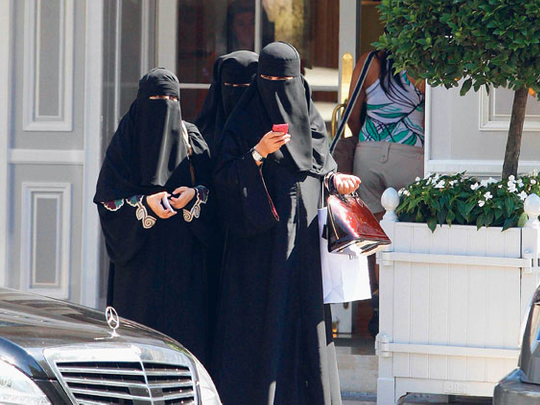
Dubai: Women in the Middle East have made significant strides over the years, accumulating massive amount of wealth and broadening their access to better education.
Research data have shown that women now control an estimated 22 per cent of the region's wealth. Females in Saudi Arabia alone are sitting on a combined fortune of $11.9 billion, all in cash.
Such enormous wealth may give financial managers and firms a reason to cheer about, but for women, the playing field remains uneven. Many of them are still overlooked and undervalued in many areas of daily life, from the workplace to business and public service.
Various studies have pointed out that closing the gender gap and tapping into women's powerful human and money capital can have positive implications for an economy.
The potential of women in the Middle East region is still clearly untapped.
For example in Kuwait, the country's nationality law prohibits Kuwaiti women married to non-Kuwaiti men the right to pass their nationality on to their children and spouses, however Kuwaiti men enjoy this right, Shailesh Dash, founder chairman of Al Masah Capital, tells Gulf News.
The company has recently released its report The Saudi Woman: A Catalyst for Change, which highlights the socio-economic disparity between men and women in the oil-rich state.
The report notes that 65 per cent of women in Saudi Arabia are employed and they account for only 0.8 per cent of the total workforce in the private sector. This, despite the fact that women constitute nearly half (45 per cent) of the population, have a literacy rate of 79 per cent, and a huge portion (78.3 per cent) of those without jobs are university graduates.
Compared to neigbouring countries such as Qatar, UAE and Kuwait, Saudi Arabia has the lowest national female labour participation rate, which stood at 20.1 per cent last year.
The report cites religious, social and political restrictions as major deterrent to women's full economic participation. (see box)
"Saudi women are facing many constraints that are hindering their overall growth potential. Saudi laws based on the Sharia principles guarantee a woman's right to work. However, their rigid definitions stop them from mixing with men, thus restricting their entry in male-dominated areas," Dash points out.
He says women in most of the Middle East economies may feel the same troubles as Saudi females, though some areas are more progressive and open. In the UAE, the female labour force participation rate stood at 38.4 per cent last year. The rate was higher in Kuwait (41.8 per cent) and Qatar (40.6 per cent).
According to the MasterCard Worldwide Index of Women's Advancement, 2010, the labour participation rate in the UAE grew further to 42.41 this year, but many still feel less empowered, with the overall index score declining from 122.24 in 2009 to 105.94 in 2010.
Household autonomy
The index shows there are less UAE women enjoying autonomy in household decision-making, as only 30 per cent believe they hold the family's purse strings this year compared to 60 per cent last year. Also, a significantly lower proportion of women perceive themselves to be in managerial positions: 71 women per 100 men in 2010, compared to 140 women per 100 men in 2009.
But overall, there's much less gender disparity in the UAE, according to Steve Gregory of Holborn Assets.
"It's also a fact that women in the UAE are educated further than men generally. There are pressures on men that cause them to start work earlier, while many women have the good fortune to be supported through higher education, he points out.
Like Saudi women, however, females in the UAE are sitting on a huge pool of idle money.
"For cultural reasons, many women do not seek advice from financial advisors... I find that women are generally less willing to take any form of risk with money, and as a consequence, fewer women than men have lost money investing in UAE property in the last three years," adds Gregory.
In addition, men have had the opportunity in the past to borrow more than women as their salaries are generally higher. If they borrowed more and invested, they (would have) lost more that now requires repayment. As a result, many have become comparatively wealthier than men, he explains.
Ishrat Kiyani, head of premium banking, wealth management and mortgages at HSBC Bank Middle East, says it would be prudent to say that UAE would follow a similar pattern to Saudi Arabia.
Large amounts of money are currently being held in cash due to the lack of confidence in the economic climate, he tells Gulf News.
There are some positive points to feel good about, however. Saudi women's investment scope is gradually broadening and their "entrepreneurial drive" is increasing. Quoting data from the UNDP National Millennium Goals Report, 2009, Dash says the number of commercially registered firms owned by women exceeded 35,400 last year.
More women in the UAE, have also taken the plunge and joined the ranks of entrepreneurship, as their proportion in the business community grew from 5.2 per cent in 2002 to 14.7 per cent in 2006, according to the Dubai Businesswomen Council.
"Women's entrepreneurship is far more robust than has been previously assumed. The number of women-owned businesses has grown over the years. One of the major trading sites [tejari.com] is run by a woman, Shaikha Lubna Al Qasimi, Minister of Foreign Trade, proving that the nation is certainly taking a proactive approach to ensure that women get their due place in society," says Henna Sohail, product manager of Dubai-based debt management agency ISDM.
Do you think more companies should open their doors to women investors? What issues do women face when it comes to finances and the workplace?








